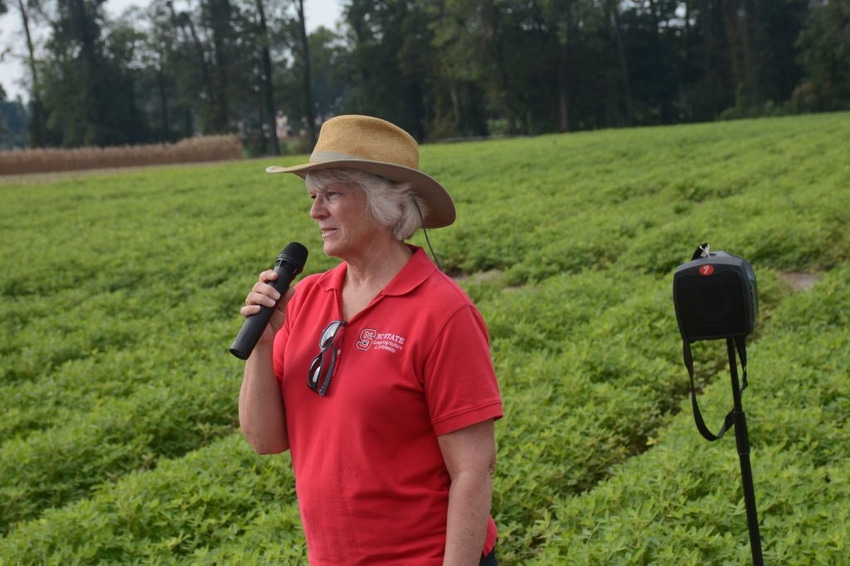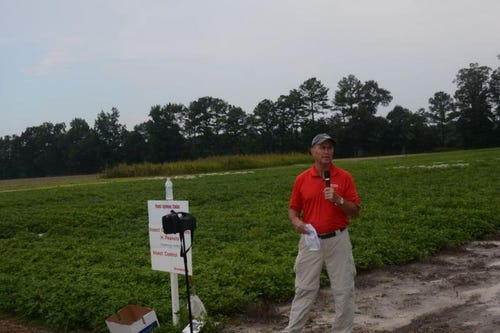
With farmers in the Carolinas and Virginia expected to turn to the high-oleic cultivars Sullivan and Wynne next year, they are curious if the disease control methods used in the highly popular variety Bailey will work in Sullivan and Wynne as well.
Bailey was released by North Carolina State University in 2008 and has garnered Superstar status in Virginia and Carolinas due to its excellent yield potential and strong disease resistance package. However, Bailey is a non-oleic variety and the peanut industry is calling on peanut farmers to produce high-oleic peanuts.
At the 64th annual Peanut Field Day held Sept. 8 at the Peanut Belt Research Station in Lewiston-Woodville, N.C., Barbara Shew, research professor and Extension specialist at North Carolina State University, said researchers are looking at a four spray program on Sullivan and Wynne similar to the program used on the varieties Bailey and Sugg.
“We are on the third year of the trial this year and leaf spot control and defoliation in Sullivan and Wynne are extremely comparable to Bailey and Sugg,” Shew said. “Averaged across the cultivars for every disease we looked at, the foliar reduced programs were equally effective in controlling disease and led to equal yield so this is good support for the fact that we can move on to having these reduced control programs in these new cultivars. When we look at full versus reduced spray programs, they are equal across the board for disease control.”
In the four foliar spray program, one spray is used to control stem rot in addition to leaf spot. For Sclertotinia blight, one to two sprays, depending on the pressure and the disease advisory for that year, is effective. For Cylindrocladium black rot (CBR), Shew said additional control is usually not needed.
Still, Shew emphasized the importance of well rotated peanuts for an effective four foliar spray program. “It all depends on having good rotations, especially when we are talking about leaf spot control,” she said.
Because Bailey has good disease-resistant traits, growers have been able to cut back on inputs if they so desire and the same approach should prove effective with the new cultivars, Shew said.
“Some growers have chosen not to cut back on inputs and that’s certainly a legitimate choice as well. But farmers do have the opportunity to cut back on inputs,” she said.
As for what products to use for disease control, Shew encouraged farmers not fret about it.
“The major products on the market are all really good and really effective and there is really not that much to be gained by spending a lot of time worrying about this fungicide versus that fungicide. They all do good jobs,” Shew said. “They do have slightly different strengths and weaknesses and there are specific spots in the growing season where it may make sense to use one versus the other but in general the major products do a great job and you don’t need to spend a lot of time agonizing over them.”
Turning to insect control, Rick Brandenburg, professor of entomology at N.C. State, notes that testing done over the years shows that products farmers now turn to are generally effective to control thrips and other pests. “The loss of Temik was not the disaster we thought it might be and we have good products that provide protection and protect the yield of these crops,” he said.
Brandenburg did note that he has received a lot of calls this year on potato leaf hoppers in peanuts, particularly in July when some farmers began to see a lot of yellow leaves. “The problem is by the time you see the yellowing, the damage has been done to the plant,” Brandenburg said.
Leaf hoppers inject a toxin into the plant that disrupts photosynthesis and causes the yellowing. “You can kill all the leaf hoppers you want but at that point the plant has been damaged, so it’s been challenging for us on how to make recommendations,” he added.
There is also concern that spraying for leaf hoppers in July may cause a spider mite problem two to three weeks later, particularly if it's hot and dry. “I feel that you have to have 50 percent or more of the leaflets yellow before you’re going to see a yield loss, but how do you predict that on the front end is really hard,” he said.
“Potato Leaf Hopper didn’t use to be that much of an issue when 70 percent of the acreage was treated with Lorsban for corn rootworm and because of Lorsban’s vapor and volatility, it would kill all the potato leaf hoppers and we’d never see that much damage. But since we reduced the amount of Lorsban for rootworm treatments, we do see more potato leaf hoppers than we’ve seen in the past."

Rick Brandenburg, professor of entomology at N.C. State, notes that testing done over the years shows that products farmers now turn to are generally effective in control of thrips and other pests.
About the Author(s)
You May Also Like






